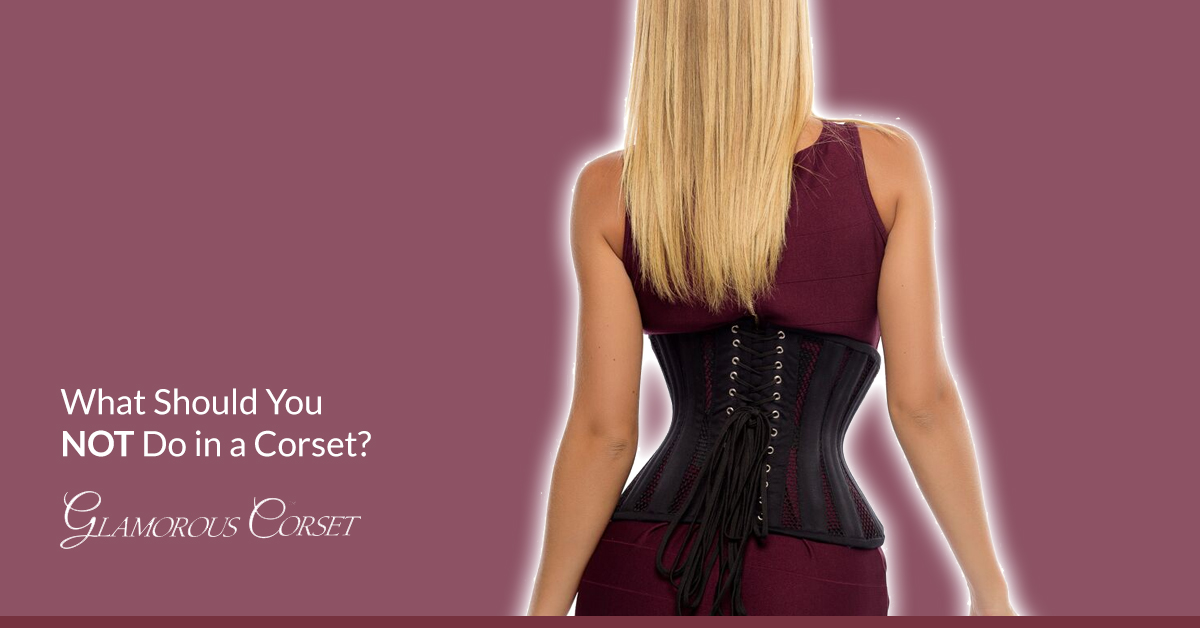Blog
What Should You NOT Do in a Corset?
Featured Corset: Jolie Short Black Mesh Corset
When you wear a corset properly, there are relatively few things you can’t do. While you don’t want to run a marathon or engage in other high-intensity activities, you can pretty much go about your day as usual when you don a waist-training corset.
Women in corsets work in offices, drive cars, cook meals, care for children, and do household chores. They ride bikes, sing songs, trip the light fantastic, and generally conduct their lives as they see fit.
Corsets are support garments designed to slim your waist, smooth your torso, and help you look svelte in every outfit. They are not meant to limit your lifestyle, and if you use them properly, you’ll never need the fainting couch.
The key, of course, is correct wear. This means purchasing the right size and style of corset for your body, setting realistic waist-training goals, and understanding your comfort level when it comes to snug wear.
In truth, the few things you should not do in a corset are mainly related to keeping your garment in good shape. What should you avoid when wearing a corset?
Don’t Lace Around the Waist
It’s true that laces are replaceable. Whether you like satin ribbon or sturdy nylon, the friction and tension on laces could eventually lead to breakage — but this portion of your garment is relatively inexpensive and easy to replace. With that being said, you don’t want to place undue strain on your laces that leads to early breakage.
This is why you should never tie laces around your waist. When you first order a corset, you’ll find that it comes with a lot of lacing material. This selection is meant to accommodate different sizes and lacing patterns. Additionally, you have to leave excess lacing material so you can loosen the garment enough to get in and out of it.
When you get your laces in order, put on your corset, and tighten it, however, you’ll discover a lot of leftover lacing. What do you do with it? Some can be trimmed as long as there’s enough left for loosening the garment to get it on and off. But what about the remaining rabbit ears (the loops of lacing in the middle of your back)?
You might think the easiest option is to simply wind them around your waist, but this is a major no-no. It not only adds extra tension to the laces but also causes friction between the laces and the garment, potentially wearing laces and damaging the fabric of your corset panels (particularly if your garment features embellishments).
The best option is to tie your laces into a bow in the back and tuck them under the hem of your corset. This should help them lie relatively flat and keep them out of sight.
Don’t Undo Busks Before Laces
If you know anything about waist-training corsets, you know that what makes them so effective is the use of steel boning. Rigid steel rods, either flat or spiral, are inserted into fabric channels sewn between panels of the corset. They act as the main source of body contouring when you cinch your corset.
There are also steel busks at the front of the garment, featuring a number of pins and loops that allow you to get into and out of your corset more easily than if the front panel were unbroken. However, busks are not meant to be a quick-release system.
The proper way to take your corset on and off is with the laces loosened. When you clasp or unclasp busks, the garment should not be snug; instead, it should have plenty of wiggle room. Why is this so important?
When you struggle to release the loops from pins in the front of a tight garment, you can not only put strain on the fabric, potentially leading to tears, but you could even break pins or warp the busks themselves.
If that happens, you’ll have to replace the busks or the entire garment. Neither is a cheap or easy fix, so make sure to loosen the laces in the back of the garment before you undo the busks to remove your corset.
Don’t Bend the Busks
The first thing you’re likely to learn when you don a corset is that you should avoid bending at the waist. Of course, that doesn’t stop some wearers from trying. To keep bending to a minimum, most corset wearers learn to shimmy into the rest of their outfits, including shoes and socks, before putting on the corset.
It’s easy to forget and try to bend over. When you do, you risk bending your busks. Your corset will bend a bit, but it’s not good for the garment. If you want to ensure longevity, learn to drop it like it’s hot rather than bending over at the waist.
To stay up-to-date with weekly blog posts, waist training tips, and the chance to win one of our monthly corset giveaways, follow us on Facebook, Instagram, & subscribe to our mailing list and YouTube channel today! Want to find the perfect steel boned corset? Shop some of our favorites: underbust corsets, overbust corsets, corset dresses. You can also shop our corsets by material: cotton corsets, denim corsets, leather corsets, mesh corsets, pvc corsets, and satin corsets. Have questions about getting started with waist training or finding the right size corset? Contact us!

My name is Rachel, I am the owner of Glamorous Corset, a small business founded by me in 2010. Back In 2005, I was in a car accident that left me with a herniated disk. Much to my surprise I learned steel boned corsets were beneficial to several medical injuries including mine. I was always intrigued with corsetry, their history and their beautiful aesthetic. I love sharing knowledge about corsets, educating my wonderful readers and breaking the negative stigma related to corsetry. In combination with my years of research and personal experience I hope my articles are useful and can help anyone who has struggled with some of the same things I have. More about me…


